A qualified sports nutritionist can take your performance to the next level.
Performance is more than just training hard – what you eat (and when) can make or break your results.
A lot of endurance athletes train hard – but fall short when it comes to nutrition. There’s so much conflicting advice out there and it can feel overwhelming.
As a competitive runner and registered sports dietitian, I help athletes of all ages and abilities take the guesswork out of nutrition so they can focus on what they do best.
In this article, I’ll walk you through the top 7 nutrition mistakes I see in training for a race and what to do instead.
I believe that every athlete can benefit from a sports dietitian.
A personalized game plan will support your training, goals, and lifestyle – maximizing your performance and potential for a better race.

Sandra Kilmartin, RD
Mistake #1 - Eating Too Much High-Fiber, Low-Calorie Foods
We’ve all heard that whole grains, fruits, and vegetables are healthy – and they are! But if your meals are mostly big salads, smoothies, and low-calorie foods, you might not be getting enough fuel for training.
Over time, undereating paired with high-intensity training can lead to relative energy deficiency in sport (REDs).
Some signs of REDs include reduced training improvements, irritability and low mood, poor sleep quality, hormonal imbalances, and hypothalamic amenorrhea.
REDs and Hypothalamic Amenorrhea
REDs (Relative Energy Deficiency in Sport) in both male and female athletes happens when the body doesn’t get enough energy (calories) to support both daily life and training.
Over time, this energy mismatch can lead to hormonal changes, reduced bone density, slower recovery, frequent injuries, and changes in mood, sleep, or digestion.
For female athletes, Hypothalamic Amenorrhea (HA) is one possible outcome of REDs, where menstrual periods stop due to low energy availability. This can happen even if you’re eating “healthy” and training hard.
It’s NOT normal to lose your period as a menstruating athlete.
REDs and HA are not just short-term issues, they can have long-lasting effects on your health, performance, and future fertility if left untreated.
With the right nutrition, training adjustments, and support, your body can heal and recover from REDs. You can get back to doing what you love without sacrificing your health.
Runner's Diarrhea
Eating too much fiber from whole foods close to your training or race can lead to cramps, nausea, bloating, or stomach upset on the course such as runner’s diarrhea.
Runner’s diarrhea is when you suddenly need to have a bowel movement during or right after a run. It’s more common during longer races and intense efforts. This happens because your body sends most of your blood to the muscles and away from your stomach, which makes digestion harder.
What to do instead?
Keep the fruits and veggies, but make room for energy-dense and easy digesting carbs like rice, oats, pasta, bagels, wraps, and sports drinks – especially around your training sessions and race day.
To reduce the risk of GI distress during and after a race, take a close look at your pre-run eating habits:
Eat something light and easy to digest (like toast or a banana) a few hours before your run, and avoid trying anything new on race day. Stick with foods, gels, or drinks you’ve already tested in training and know your stomach can handle.
Lower fiber intake, reducing high FODMAP and/or gas-producing foods, a day or two before a race may help you experience less GI symptoms during and after your race.
Mistake #2 - Only Focusing on Protein
Protein is important, but it’s not the only important piece in endurance sports recovery.
More protein does not equal faster recovery if carbohydrate intakes are inadequate.
Many athletes load up on protein powder, protein shakes, or protein bars post-workout and do not eat enough carbs.
Without enough carbs, your body will use the protein for energy instead of repairing and building muscles.
What to do instead?
Aim to eat both carbs and protein within 30 minutes after training. A good rule of thumb is to eat 3 to 4 times more carbs than protein.
Here are some examples of what that might look like:
- 2 slices toast with 2 eggs and 1 medium fruit (30g carbs, 13g protein, 11g fat)
- 1 banana with 2 tbsp of peanut butter (27g carbs, 8g protein, 16g fat)
- 1 cup smoothie with 30g oats and ¾ cup Greek yogurt. (47g carbs, 16g protein, 2g fat)
You don’t need to necessarily track numbers.
Instead, focus on building meals and snacks that combine quality carbs and protein, and eating enough to feel satisfied and energized.
Mistake #3 - Not Using Sugars for Fuel
Let’s say you’re taking a gel every 45 minutes during a long run. That sounds okay, right?
Well, that adds up to only about 30 grams of carbs per hour and for most endurance athletes, that’s not enough.
Here is a missed opportunity I often see: Not using sports drinks or other easy-digesting carb sources because “they have too much sugar”.
Many athletes, especially those who are conscious about eating healthy, may struggle with the idea of intentionally taking in more sugar.
Strategic use of sugars during training and racing will not harm your health or your goals – instead, it can help with your performance.
When your runs get longer than 75-90 minutes, your body needs quick-access energy to keep your performance up and avoid that dreaded “bonk” or wall. That’s where fast-digesting carbs like glucose and fructose come in.
Sports drinks, gels, chews – these are all forms of sugar that can be rapidly absorbed, keeping your energy levels stable during and even after your runs.
What to do instead?
For shorter exercise durations (ie. under 2.5 hours) 30-60 grams of carbs per hour will sufficiently fuel most efforts.
You can do this with a mix of sports foods like gels, chews, and carb-based drinks and other foods like gummies, candy, dried fruit, or banana.
Gradually train your gut to handle 60-90 grams of carbs per hour for exercise lasting over 2.5 hours.
When pushing higher carb intake, it is best to use sports foods like gels, chews, and carb-based drinks as these are specially formulated with both glucose and fructose to lessen risk of GI upset.
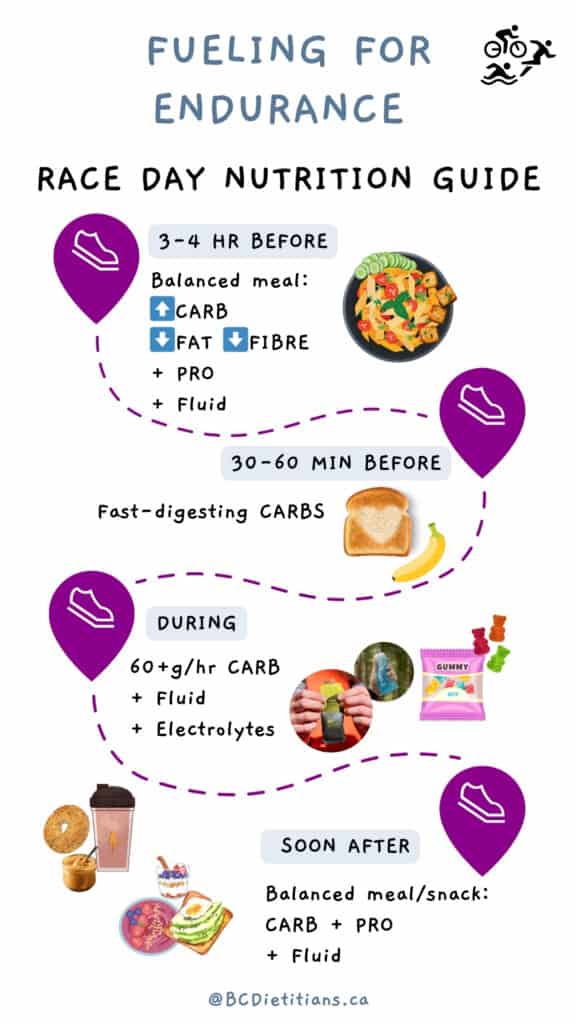
Mistake #4 - Banking on Sports Supplements
Basics over bells and whistles every time.
It’s easy for athletes to get caught up in the hype of sports supplements or ergogenic aids in hope to improve their performance – caffeine, pre-workouts, BCAA, electrolytes, creatine, ashwagandha, rhodiola rosea, beetroot juice, you name it.
But those won’t do much if your daily nutrition isn’t dialed in.
What to do instead?
Supplements are most helpful when you have a solid nutrition plan.
If you’re skipping meals, not eating enough carbs, or under-hydrating, no amount of electrolytes or pre-workout powder is going to help.
Instead focus first on:
- Eating enough calories each day
- Understanding macronutrient ratios for your needs
- Timing your meals/snacks around training
- Training your gut with the proper fuel during longer workouts
- Staying hydrated and getting enough electrolytes
Supplements to Consider for Endurance Athletes
Before you turn to supplements to give you an edge, make sure that you’re eating a healthy, balanced diet that is rich in nutrients.
The following supplements are popular amongst athletes and may offer potential benefits. A sports dietitian can help you create a tailored supplement plan:
Electrolytes – Help maintain fluid balance and support muscle function, especially during long workouts or in hot, humid conditions.
Caffeine – With appropriate dose and timing, may help improve focus, reduce perceived effort, and increase muscle contractile function when taken before and/or during exercise.
Creatine monohydrate – Best known for power and strength; can support short bursts of high-intensity work within endurance training.
Sodium bicarbonate and beta alanine – can both reduce lactic acid build up and muscle fatigue. These are most helpful in efforts lasting ~1-10 min long or in longer events when sprint to finish is crucial.
Protein Powder – A convenient way to help meet daily protein needs when whole food options aren’t available. Can be helpful after races or hard sessions when appetite is low, offering easy-to-digest liquid nutrition when mixed with water or milk.
Supplements might support performance when used strategically, but more does not always mean better. Consult a sports dietitian for a tailored nutrition and supplement plan.
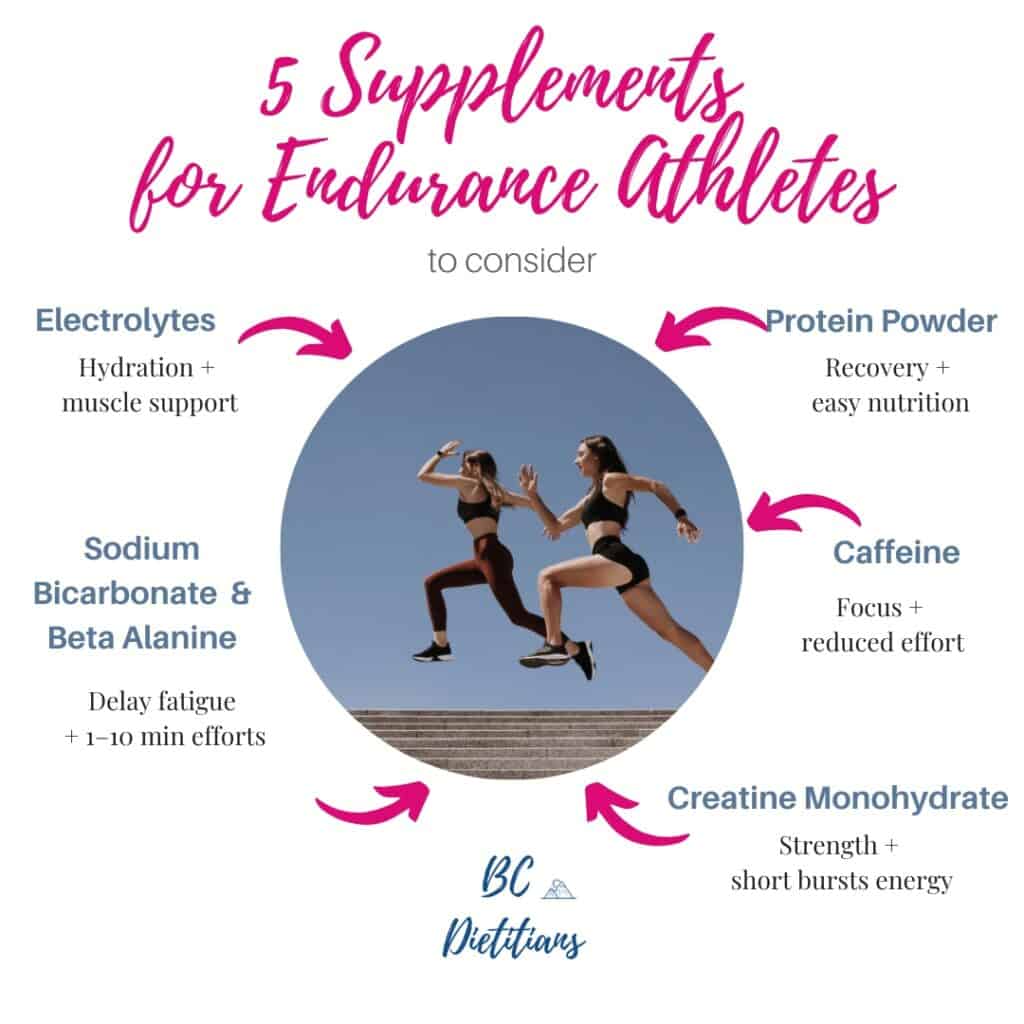
Mistake #5 - Relying on Your Hunger Cues to Eat
Many nutrition experts will say “Eat when you’re hungry and stop when you’re full.”
But high-intensity training, long sessions, or high heat conditions can suppress your appetite.
If you wait until you feel hungry to eat, you may end up undereating without realizing it. Over time, that can lead to low energy, poor recovery, disrupted hormones, increasing your risk of developing REDs and/or injuries.
What to do instead?
Follow a structured fueling routine around your training to help ensure your energy needs are consistently met.
Plan out your meal and snack times and try to loosely follow that routine – even if you’re not super hungry.
It’s super helpful to test out the timing of your eating with your training sessions so there are no surprises on race day.
After a race or hard workout, if you’re not ready to eat solid food, go for a smoothie or drink that includes carbs and protein. Liquid nutrition can be a great first step toward recovery when your stomach isn’t quite ready.
Mistake #6 - Obsessing Over ‘Race Weight’
Being lighter doesn’t always mean you’ll be faster.
Some athletes might fall into this belief that being lighter means being faster. But chasing a specific number on the scale – especially close to race day – can do more harm than good.
Trying to lose weight during a training cycle can lead to under fueling, muscle loss, mental burnout. Most importantly, performance suffers when your body doesn’t have enough fuel to support the energy expenditure.
Well-fueled athletes typically train harder, recover faster, and perform better regardless of their weight.
What to do instead?
Instead of chasing a scale number, focus on how you feel and perform in training.
Are you gaining strength and power? Recovering well? Holding pace? Staying energized? That’s what matters.
Mistake #7 - Training for a Race Without Planning Your Nutrition
You’ve got your training plan dialed in – mileage, intervals, long runs. But what about your fluid and nutrition strategy?
I often see athletes focus heavily on physical training but leave nutrition as an afterthought. This leads to missed opportunities to fuel properly during training, and practice a plan that actually works under race conditions.
If you’re not eating in a way that supports your training, you might notice:
- Slower progress and poor recovery
- Increased risk of injury
- GI issues on race day because you didn’t practice fueling
- Feeling drained during longer sessions
What to do instead?
Most training seasons can span 12-20 weeks to allow time for testing different eating strategies and helping your body adapt.
So start thinking of nutrition as part of your training plan, not separate from it:
- Practice fueling and hydration during long workouts
- Support recovery with balanced meals and snacks
- Adjust intake based on your training volume and intensity
Your nutrition plan isn’t something you can finalize in the final taper week, so don’t wait until a month before your race to figure it all out.
I worked with a client training for the BMO Marathon who came to me because he recognized nutrition could be a game-changer. We worked on his carb intake, hydration, and electrolyte strategy. For him, this meant carrying a flask during the race – aid station cups just weren’t enough for his individual sweat rate. After he ran a huge personal best, he told me he noticed a big difference, and didn’t struggle as much with fatigue, dehydration, or cramping by the final 10K.
How a Sports Dietitian Helps You Perform at Your Best
If you’ve ever found yourself grinding your way through the last 10k, feeling tired, feeling lost with all the nutrition information, or running into stomach problems, it does not have to be this way.
You don’t have to figure it all out on your own. I can help you with the key to hitting a personal best in your next marathon.
I help endurance athletes with:
- Customized fueling plans for training, recovery, and race day
- Meal timing, hydration, and supplements
- Support for GI issues, food intolerance, and sensitivity
- Fueling properly while managing a busy schedule
- More energy, fewer injuries, faster recovery, and stronger finishes
- REDs prevention and recovery, including regaining a lost period due to hypothalamic amenorrhea
Whether you’re training for your first race or trying to hit a new personal best, the right nutrition strategy can make a huge difference.
Final Takeaway
If you’re making one (or more) of these mistakes, you’re not alone.
Nutrition isn’t about perfection – it’s about leveraging your potential. Strategizing your nutrition will give your body what it needs to show up and perform at its best.
Are you ready to stop guessing, fuel with confidence, and take your training to the next level?
Book a free call with me today! Work with a qualified sports dietitian who gets what it’s like to be an athlete.
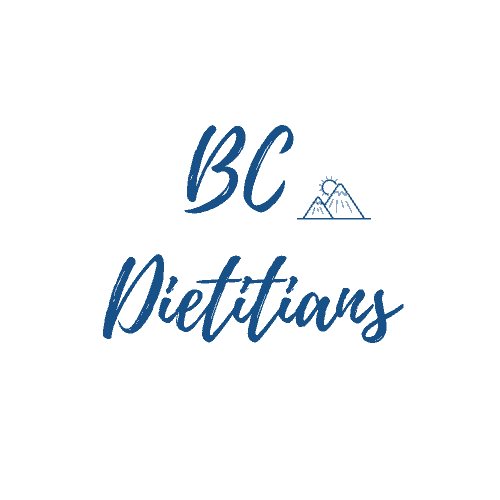


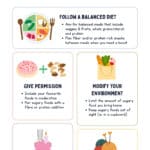


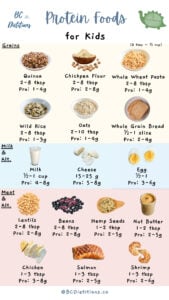

Add a comment